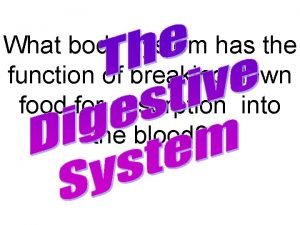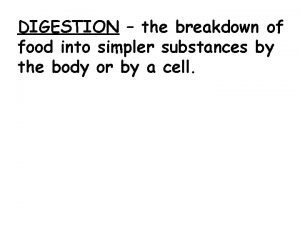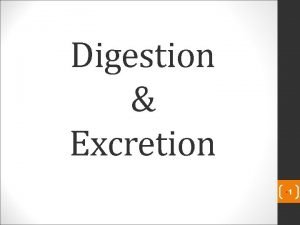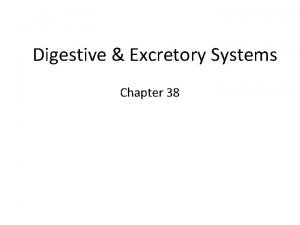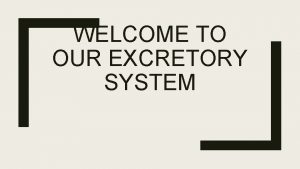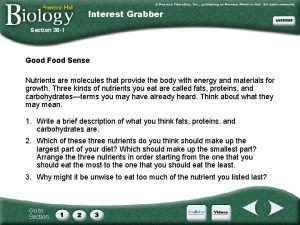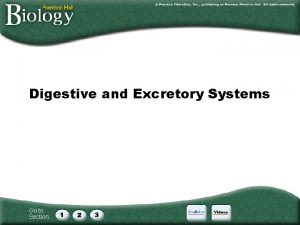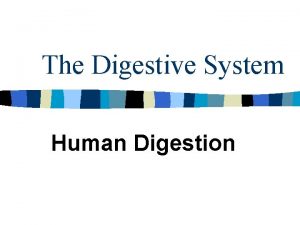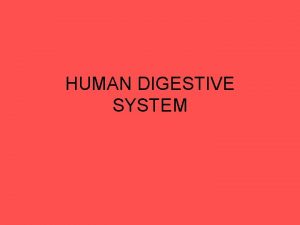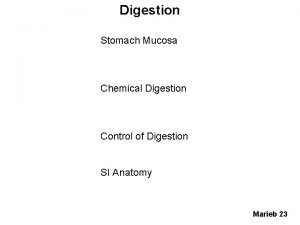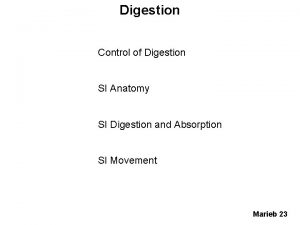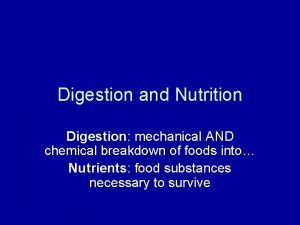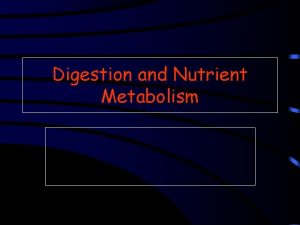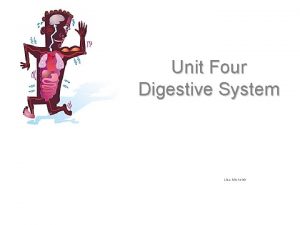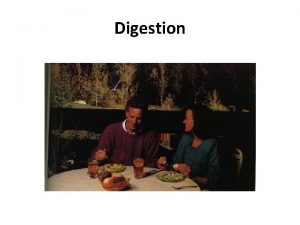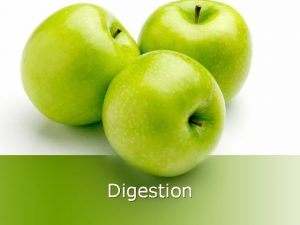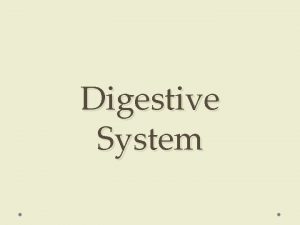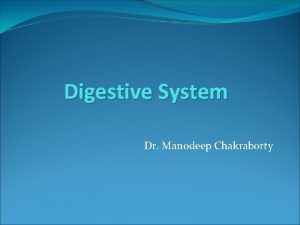Digestive System Digestive System I DIGESTION THE PROCESS
















- Slides: 16

Digestive System

Digestive System I. DIGESTION – THE PROCESS THAT BREAKS FOOD INTO SMALL MOLECULES SO THEY CAN BE ABSORBED OR TAKEN INTO BODY CELLS. Mechanical digestion Food chewed and mixed in mouth. 2. Food churned in stomach. 3. Food acted on by bile. A. 1.

Digestive System B. CHEMICAL DIGESTIONS Breaks down large molecules to smaller. 2. In mouth , stomach, small intestines 3. Enzymes a. Proteins vital for chemical digestion b. Enters a reaction and helps to join or break up into substances c. Are not changed themselves d. Can speed up reactions 1.

Digestive System II. DIGESTION IN MOUTH A. B. 1. a. b. c. Mechanical digestion by tongue and teeth Chemical digestion Saliva Produced by the 3 sets of salivary glands Mostly water, but also contains mucus and enzymes (amylase) Amylase starts breakdown of starch to sugar. DIAGRAM OF THE MOUTH

Digestive System C. ESOPHAGUS Muscular tube 25 cm. long No digestion Peristalsis- waves of contractions that move food a. Takes about 4 to 8 seconds b. Peristalsis found throughout digestive systems 1. 2. 3. 4. ESOPHAGUS DIAGRAM

Digestive System III. DIGESTION IN THE STOMACH A muscular bag with folds on the inside B. Mechanical digestion done by walls of stomach and peristalsis. A. Real view DIAGRAM OF THE STOMACH

Digestive System C. CHEMICAL DIGESTION Hydrochloric acid Enzymes work on protein Mucus Lubricates food, making it slick b. Protects stomach lining from strong digestive juices D. Food in stomach about 4 hours E. Food changed to chyme - thin , watery liquid 1. 2. 3. a. INSIDE THE STOMACH

Digestive System IV. DIGESTION IN THE SMALL INTESTINE A. B. 1. 2. a. 1. 2. Small in diameter, but about 6 -7 M long - first part of the duodenum small intestine Major part of all digestion Receive digestive juices from outside the digestive tract Bile From the liver Greenish color SMALL INTESTINES DIAGRAM

Digestive System SMALL INTESTINES CONTINUE 3. Store in small sac : the gall bladder 4. Breaks fat molecules into smaller pieces (like detergent acts on grease) b. Pancreas 1. Produces insulin - helps body use sugar and other carbohydrates 2. Produces enzymes that break down carbohydrates, fats, proteins still further DIAGRAM OF GALLBLADDER

Digestive System C. WALLS OF SMALL INTESTINE Many ridges and folds Folds covered with villi Tiny, finger like projections b. Make surface area larger so there are more places for to be absorbed. 1. 2. a.

Digestive System D. CHYME IS NOW A SOUP OF MOLECULES READY TO BE ABSORBED THROUGH CELLS ON SURFACE OF VILLI. Molecules of nutrients pass by diffusion and osmosis or by active transport into blood vessels of each villus. 2. Remaining materials are moved into large intestines by peristalsis. 1. CAPILLARIES AROUND THE VILLUS

Small Intestine

Digestive System V. ABSORPTION IN LARGE INTESTINE A. B. C. 1. 2. Main job: absorb water from the thin mixture (chyme) Homeostasis is maintained. Peristalsis slows down some. Chyme may stay in large intestine for 3 days Water and sodium are absorbed. LARGE INTESTINES

Digestive System D. REMAINING MATERIALS Undigested cellulose Bacteria Feed on undigested matter b. Produce vitamins. c. This is an example of a symbiotic relationship. 1. 2. a.

Digestive System E. RELEASE OF SOLIDIFIED WASTES Controlled by muscles in the rectum and anus. 2. Release in the form of feces. 1.

Digestive System REMEMBER Food is processed in your digestive system for the purpose of supplying your body with raw materials for metabolism. These raw materials are in the form of nutrients. COLON:
 Mechanical and chemical digestion venn diagram
Mechanical and chemical digestion venn diagram Respiratory digestive and circulatory system
Respiratory digestive and circulatory system Intracellular digestion
Intracellular digestion Steps in digestion
Steps in digestion Section 38-2 the process of digestion answer key
Section 38-2 the process of digestion answer key The digestion process
The digestion process Carbohydrate digestion begins in the
Carbohydrate digestion begins in the Section 38-1 food and nutrition answer key
Section 38-1 food and nutrition answer key Section 38-3 the excretory system
Section 38-3 the excretory system Questron microwave digestion system
Questron microwave digestion system Human digestive system diagram class 10
Human digestive system diagram class 10 Hát kết hợp bộ gõ cơ thể
Hát kết hợp bộ gõ cơ thể Frameset trong html5
Frameset trong html5 Bổ thể
Bổ thể Tỉ lệ cơ thể trẻ em
Tỉ lệ cơ thể trẻ em Voi kéo gỗ như thế nào
Voi kéo gỗ như thế nào Thang điểm glasgow
Thang điểm glasgow
